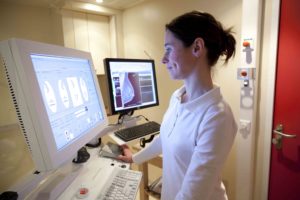Nuclear Cardiac Stress Test
Before you come, fast from midnight the previous night to help limit the amount of activity that is picked up by the intestines. Do not take your cardiac medications that morning that you normally take. This can interfere with your heart rate readings for the scan. Wear comfortable clothes that you can walk on the treadmill with good shoes. Leave valuables at home so that we don’t lose them.
Injection and Heart Scan
Begin with an IV to inject radioactive material. The injection is a resting injection, and we’ll wait 45 minutes for the trace to work its way into the heart muscle. We’ll put you on the camera for about 8 minutes. We’ll put a couple of little patches on you to help monitor your heart rate. Lay still and breathe normally.
Treadmill
Following the initial 8 minute scan taken 45 minutes after the injection, the EKG and the lead hookups. The hook-up for this portion of the cardiac heart stress test monitors the heart rate rhythm. To stress the heart a little we use a treadmill to see how it functions. The age of the patient is the factor to help us determine how high we get the heart rate. Usually, the treadmill walk lasts 5 to 10 minutes.
If you can’t do the treadmill (e.g. a heart condition, hip, knee, or ankle injury) there is a chemical that increases the heart rate, increasing the stress on the heart. It opens all the arteries and veins. There are a few normal side effects that can happen- you can feel your heart rate going up, it might be a little more difficult to breathe because your body thinks you’re exercising. All of the arteries and the veins in your whole body are opened up and so you might feel flushed. Sometimes a little bit of a headache or some abdominal discomfort occurs.
Isotope Injection at Target Heart Rate
Once the target rate is reached, an isotope is injected. Continue exercising for another minute. Then rest for five minutes while your heart is being monitored.
Continue Scan
After about 30 minutes following the EKG/treadmill portion. Patients return to the scanning room. Then pictures are taken once again of the cardiac area for about 6 minutes. Just like the first set, patients lay still on the bed and the camera goes around them.
Completion
The IV is removed and patients are escorted to the front door. Eat and drink as normal or as your doctor recommends. Continue medications that you may have. Cardiologists from the Idaho Heart Institute read these heart scans. Generally, within a day or two, your doctor will receive these results.
Hepatobiliary Scan
HIDA Scan
Hepatobiliary Iminodiacetic Acid Scans or HIDA Scans look at the function of the gallbladder.
Come after fasting from midnight the previous night. Then we’ll start an IV. We will help you get comfortable on the bed- this is a 90 minute test. Then a radioactive isotope is injected through the IV. Your liver filters out the isotope over the first hour. Then it turns it into bile so that it will fill up the gallbladder. We want to see if the gallbladder will fill and if it will empty.
We will put a table on each side for you to rest your arms so they’re more comfortable. Following this we watch for an hour as the liver filters and fills the gallbladder. After the hour we use a synthetic hormone through that same IV that makes the gallbladder think that you’ve eaten something nice and fatty. Now we watch the gallbladder contract. This medication may reproduce some of the same symptoms you’ve been having. Not everybody feels something, but some people do. We run the hormone for about 15 minutes. We take your IV out and watch for another 15 minutes. After the scan is over, we escort you to the front door. You can eat and drink like normal, unless your doctor has any restrictions. Take any medications that you may have held. Usually within 24 to 48 hours your doctor will receive the results from the Hepatobiliary Scan, and you’ll get the results from your provider.
How does a nuclear medicine bone scan work?
Bone Scan
We start a small IV and inject a small dose of a radioactive isotope. The dose is small enough that there should be no negative side effects other than a little taste in the mouth after injection. The IV will be removed at this time. You don’t need to do anything else, in particular, to prepare for this nuclear medicine bone scan (e.g. fasting, exercises). However, higher amounts of bismuth and barium can impact test results. Bismuth is most commonly found in antacids like Pepto-Bismol. Barium is used in CT scans. Inform the doctor if you have recently had a CT scan or taken Pepto-Bismol.. The scan is completed 3 hours after the injection. Please drink plenty of fluids- more than 16 oz.
We will have you lay on the bed on your back. The machine will then measure your body from head to toe. Please place your arms down to your sides so they’re comfortable. Then we’re going from head to toe on a whole-body bone scan.
The scanner calculates that it will take about 17 minutes to scan. We will have you lie still and relax as the scanner comes pretty close. We have the ability to play music to help you relax and pass the time.
You can eat and drink as normal unless your doctor has any restrictions that I don’t know about. You can take any medications that you may have had as usual. within 24 – 48 hours your doctor will receive your results, and you’ll get those results from your provider.

